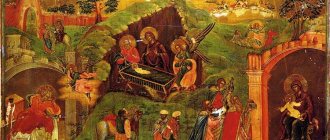The evening before this day has long been known as Vasiliev: after all, it is also the day of remembrance of St. Basil the Great, beloved saint by many, creator of the rite of liturgy. In addition, January 14 is the so-called “old New Year”, that is, January 1 of the “old” style, according to the so-called Julian calendar (as opposed to the civil, “Gregorian”) adopted by the country before 1918, and by the Church until ours days. But not everyone knows about the important spiritual significance of the Feast of the Circumcision of the Lord, also celebrated on January 14.
Why does the Feast of the Circumcision of the Lord not have the status of the Twelfth?
The point here is not only the general spiritual ignorance of many of our contemporaries, who have been cut off from tradition for generations over the years of atheism. After all, back at the beginning of the 20th century, when there were many believers who remembered pre-revolutionary times, Metropolitan Veniamin (Fedchenkov)
wrote
:
“Maybe even many people don’t know this holiday. In any case, in the minds of believers, this holiday is one of the most obscure. It’s definitely not a holiday for pilgrims... It is clear that Circumcision somehow captures our soul little by its very essence..."
Sometimes they say that the celebration itself is so “inconspicuous” because it falls between two great “twelves” (that is, from among the most important holidays established by the Church). This is Christmas (January 7) and the Baptism of Jesus Christ (January 19) .
But it's not only that. Church from the 4th century established that the holiday belongs to the “great” ones, but is not among the twelve main ones. Probably because:
- the event refers to the Lord's fulfillment of the Old Testament norm; The apostle first insisted that the Law of Moses (containing more than 600 different instructions, including circumcision) in its entirety cannot and should no longer be fulfilled by Christians. Paul, the preacher of the True God among the pagans, then the First Apostolic Council directly speaks about the same thing (49);
- in addition, the event related to the earthly life of the Savior, and Christians already from the 1st century. We proceeded from the words of the same Paul: “from now on we know no one according to the flesh; but even if we knew Christ according to the flesh, now we no longer know him. Therefore, if anyone is in Christ, he is a new creation; The old things have passed away, the new things have come” (2 Cor. 5:16-17).
At the same time, the events of the Lord’s earthly life, including this, were always dear to His disciples, which is why the holiday is still “great.”
What is the Circumcision of the Lord
The Circumcision of the Lord is a great Christian holiday established in memory of the sacred ritual of circumcision over the Infant Jesus Christ. In Orthodoxy it is one of the Lord's holidays. That is, those with which the Church solemnly glorifies Christ, remembering significant episodes of His earthly life.
Icon of the Feast of the Circumcision of the Lord
The Russian Orthodox Church, which has adopted the Julian calendar, celebrates the Circumcision of the Lord on January 14. The Catholic and some other local Orthodox Churches follow the Gregorian calendar and therefore celebrate this holiday on January 1. The reason for the discrepancy in dates is the 13-day difference between the calendars (new and old styles).
Event of the holiday, which is celebrated on January 14
Of all the Evangelists, only St. describes him. Luke. It's very short:
“And after eight days, when the child should have been circumcised, they gave him the name Jesus, which the angel had called before he was conceived in the womb” (Luke 2:21).
At the same time, what is important for the Evangelist is not the ritual itself, but rather the naming of the name: Jesus (in Hebrew - Yehoshua, that is, “Jehovah saves”).
The Evangelist says practically nothing about the perfect circumcision itself. This is connected, of course, with the attitude of Christians in general to the Law, as a “schoolmaster to Christ,” the fulfillment of which is not necessary for Christians.
The meaning of the Gospel testimony about the circumcision of the Infant God
Already from the end of the 1st century. it had an apologetic meaning: the Church was confused by heretics, adherents of the doctrine of so-called docetism (from the Greek “to seem”), who believed that the Incarnation of Christ on earth was “ghostly.” The circumcision according to the Law, which He, the Child, underwent, just showed: Jesus is a Perfect Man. The echo of this controversy is not only the status of the holiday, albeit “Old Testament”, but still “great”, but also its Greek name:
“Ή κατά σάρκα Περιτομή τού Κυρίου καί Θεού καί Σωτήρος ημών Ιησού Χρισ τού”, literally translated into Slavic as “The Hedgehog according to the flesh is the Circumcision of the Lord and God and the Savior of our Jesus Christ.” Namely, “according to the flesh.”
Circumcision of Jesus Christ
The Divine Infant was given the name Jesus at circumcision, which was brought from Heaven by the Archangel Gabriel during the Annunciation. The name Jesus (from the Hebrew “Yehoshua”) consists of two roots: the name of God – Yahweh and the word “salvation”. Therefore, we can understand the name Jesus as God the Savior. The Archangel himself explained this name to Joseph in a dream: “You shall call His name Jesus, for He will save His people from their sins” (Matthew 1:21), because only God can save from sins.
The circumcision was performed by Joseph the Betrothed, guardian of the virginity of the Mother of God. Joseph was not only a spectator of those wonderful days, but also appeared to the uninitiated in the mystery of seedless conception as the father of the Child. Circumcision was performed according to the law by the father of the child, thereby passing on to his son a sign of belonging to the chosen people.
Through circumcision we have clearly seen that Christ is Man. God took on flesh. Our flesh. In ancient times there were heretics, the Docetes, who said that God incarnated ghostly, only creating the appearance of physicality. The fact that Jesus was circumcised refutes this lie. Saint Ephraim the Syrian says: “If Christ was not flesh, then whom did Joseph circumcise? But since He was truly flesh, He was circumcised as a man, and the Child was truly stained with His blood, like the son of man; He was sick and cried in pain, as befits someone with human nature.” The Church points to the reality of the Gospel events and values them. This is the path of our salvation.
David said: “...my mother gave birth to me in sins” (Ps. 50:7). On the eighth day, a sore on the baby’s body indicated guilt in sins. The Lord is sinless, accepts circumcision to show that He becomes the Sacrifice for our sins and accepts our illnesses (Isa. 53). “And for what He was not guilty, for this He suffered as if innocent, as if repeating with David: “What I did not take away, I must give” (Ps. 68:5), i.e. for that sin in which I was not involved “I accept the disease of circumcision,” as St. Demetrius of Rostov writes, “...in circumcision the Master showed us greater humility than in His birth. For at His birth He took upon Himself the form of a man...; in circumcision He took on the form of a sinner, just as a sinner endured the pain due for sin.”
He accepted circumcision to fulfill his covenant with God in a new way. The Lord indicated that the circle of flesh is ending. A new era is beginning, where the words of the prophets will no longer be empty and Christians will circumcise the periphery of their hearts, where all sins are located, and give a pure heart to God. Sschmch. Thaddeus (Uspensky) notes: “It was performed in the image of cutting off the passions of the flesh, cutting off the hardness of the heart itself, which was so disastrous for Israel and so often forced it to retreat from its God. And so our Lord, being sinless, Himself endures circumcision in order to teach to submit to the will of God those who require circumcision of hearts, cleansing from a multitude of sins: “... the Creator of the law fulfills the law,” in order to show by His example how no one can come to God apart from the law of the Lord.” .
History of Old Testament ritual
It goes back to the very beginning of the Jewish religion, when the command to perform it was given to the forefather Abraham directly by God:
“This is My covenant, which you shall keep between Me and you and your descendants after you [in their generations]: All your males shall be circumcised; circumcise your foreskin: and this will be a sign of the covenant between Me and you. From birth eight days every male child among you shall be circumcised... But the uncircumcised male child who does not circumcise his foreskin [on the eighth day] shall be cut off from among his people, for he has broken My covenant” (Gen. 17:10-14).
These words were spoken to Abraham when the old man was already 99 years old. Then he and all the men in his family went through the ritual.
Exodus from Egypt. Circumcision of Eliezer, son of Moses. Painting of the Sistine Chapel, Vatican. OK. 1482 Artist. P. Perugino
A year passed, his wife Sarah, despite her old age, gave birth to the forefather’s son, Isaac, which became a visible sign of God’s special favor to the righteous man. From that time on, the Jews strictly observed the commandment given centuries before the Law of Moses.
What is circumcision
This is essentially a surgical operation to remove the foreskin in boys or men. The latter most often occurs now when they undergo the so-called conversion - the transition to Judaism of those who are not Jewish by birth. Circumcision can now occur:
- · in the synagogue, after prayer in the morning;
- · Houses; 10 men must be present (this includes all Jews over 13 years of age);
- · in the hospital, but with the presence of a rabbi
Any Jew, or even (if the man is not around) a woman of the Jewish faith can perform the ritual. In practice, this is done by a specially trained person called a mohel, or by an ordinary doctor if everything happens in a hospital. A special participant in the ritual is the one who holds the baby in his arms during it. Such a person is called a “sandak”. This word, of Greek origin, means “protector” or even “who gave birth at the same time,” in fact, a second father.
When is circumcision performed in Judaism?
This happens on the 8th day after the birth of the child, but only when he is completely healthy. If the child is sick, circumcision is postponed.
Why is such a procedure necessary?
Its meaning is, first of all, spiritual. The Bible directly states: “... the life of every body is its blood, it is the life of it” (Lev. 17:14). The blood flowing from the male organ that gives life is the dedication of the whole person, his thoughts, actions, to the Creator. The covenant of God with man is an agreement between two. On the human side, it is held together by blood, by what life is given by the Lord.
Circumcision. Artist Tintoretto 1518-1594. Fragment of the picture
Moreover, from the time of Abraham, "uncircumcised" meant "unbeliever", uninitiated, not a member of the society of Israel; circumcision separated the Israelites from other pagan peoples;
The rite of circumcision: history and meaning
What is the circumcision of the Lord? The circumcision procedure involves removing the foreskin of males. From a practical point of view, circumcision is justified on hygienic and aesthetic grounds. It is believed that the procedure reduces the risk of contracting infectious diseases.
Circumcision was practiced for religious purposes by many ancient cultures. In Old Testament Judaism (in which Christ was born), the ritual symbolized the dedication of the baby to God. The emergence of the sacred rite is directly related to the ancestor of the Jewish people - the prophet Abraham. He lived at the turn of the third and second millennia BC.
According to the Old Testament book of Genesis, the Almighty entered into a covenant (agreement) with the childless righteous man Abraham. The Creator promised him His blessing and abundant offspring, which would form a great nation (Gen. 12:2). The prophet and his entire family, in turn, had to remain faithful to the true God. The Almighty also commanded His chosen one to establish the custom of circumcision - the symbolic cutting off of sin from a person. The ritual became a visible, outward evidence of the covenant made between man and God (Gen. 17:10-14).
Circumcision was one of the few Divine commandments sent down to the Jews before the Law of Moses. For the descendants of Abraham, it became a symbol of loyalty to the Creator, belonging to God's chosen people and isolation from the rest of the pagan world. Blood among the Jews was considered the sacred carrier of life. In this regard, the rite of circumcision acquires additional symbolic meaning. By shedding blood from the reproductive organ, a person seems to offer his whole life as a gift to God.
The spiritual meaning of the holiday in Christianity
Besides the fact that it speaks of Christ as real, and not “apparent,” as the Docetes taught, Man, the event of Circumcision:
- · testifies to the deep humility of the Lord, who takes upon Himself the fulfillment of the Law established by Him;
Metropolitan Veniamin (Fedchenkov) writes: “Those who intend to live by new laws must first fulfill the old ones. This will show that he is truly a “law-abiding” person, and not a self-willed person. He only has the right to establish a new one who has fulfilled the old. The Lord came to establish the New Law, and He necessarily had to fulfill the Old one.”
- · it is also the beginning of the suffering of the Son of God, prefiguring His Way of the Cross, a sacrifice for the salvation of people;
- · finally, this is an example for Christians; the path to God begins with the fulfillment of church regulations: now you forced yourself to get up early to come to the service, now you limited yourself in food during fasting, but now time has passed - and you forced your soul to think about sins in confession; this is already the beginning of it transformation.
Unfortunately, many, somewhat relaxed after the Nativity Fast , think little about this on the Feast of Circumcision, so “unnoticeable” among others.
When the ritual was made optional for Christians
The initial history of the Church, described by St. Luke in the Acts of the Apostles, testifies that the first decades of the existence of Christian communities were a time of discussion - in some places quite heated - about the circumcision of former pagans who were re-joining the Church, and in general - about their observance of the Law. The problem arose immediately after the new teaching went beyond the borders of Palestine and the people of Israel, becoming the property of the inhabitants of the Roman Empire of various nationalities.
Sermon of the Apostle Paul. Mosaic
Many who preached Christ confused the pagans, demanding from them the fulfillment of the Law, and, above all, circumcision. To resolve the issue, it was necessary to convene the Council of the Apostles. By this time:
- · the story has already happened with the Baptism of the pagan centurion Cornelius, moreover, of his entire house, at the hand of St. Peter, who had previously had a special heavenly vision, by which, to his embarrassment, the Apostle was offered to taste ritually unclean (according to the Law) food; then a voice from heaven said three times: “What God has cleansed, do not consider unclean!” (Acts 10:15);
Speaking about the Baptism of the pagans, St. Peter exclaims: “God, who knows the hearts, gave them a testimony, giving them the Holy Spirit, just as he did to us; and made no difference between us and them, having purified their hearts through faith. Why are you now tempting God, desiring to place on the necks of the disciples a yoke that is not could neither our fathers nor we bear it?
- · baptized many “uncircumcised” by another Apostle, Paul.
It was their opinion that became the main one when making the following decision of the Council, addressed to pagan Christians:
“Apostles and elders and brethren, to the Gentile brethren who are in Antioch, Syria and Cilicia: rejoice. Since we heard that some who came out from us confused you with their speeches and shook your souls, saying that you must be circumcised and keep the law, which we did not entrust to them, then we, having gathered together, unanimously decided, having chosen men, to send them to you with our beloved Barnabas and Paul, men who gave up their souls for the name of our Lord Jesus Christ...
For it pleases the Holy Spirit and us not to place any more burden on you, except for this necessary: to abstain from things sacrificed to idols and blood, and things strangled, and fornication, and not to do to others what you do not want to do to yourself. By observing this, you will do well. Be healthy."
This decree completely abolishes circumcision for Gentile Christians. However, it is known that the Jerusalem community, which consisted of Jews, continued to observe the entire Law of Moses. After the destruction of the city (70 AD), the importance of this most authoritative of the Churches fell, and the tradition of circumcision did not continue.
The history of the holiday
The Circumcision of the Lord has an ancient history. The festival was first mentioned in the 4th century, when Christian communities began to celebrate Christmas as a separate holiday.
Like all Jewish boys, Jesus of Nazareth underwent the painful rite of circumcision on the 8th day of his birth. Then he received his name, which the Archangel Gabriel indicated to the Virgin Mary when he appeared with the good news.
The Jews adopted the ritual from the Egyptians. It is still practiced in Orthodox Jewish communities; all newborn boys must undergo it as descendants of Abraham, who entered into a covenant with God. The eighth day of a baby’s life was not chosen by chance; the number 8 symbolizes fullness and the achievement of perfection. The blood released from a wound is considered sacred by the Jews.
Postponing the event to a later date was unacceptable and indicated a disdainful and frivolous attitude towards God's laws. Only boys were subjected to the procedure. Among the Jews, husband and wife are one, they must have the same blood and one faith, that is, belong to the same people, therefore, to bless the family, it is enough for the man to be circumcised.
The Feast of the Circumcision of Christ had a significant impact on the direction of the development of Christianity. At the end of the 1st century, Christians split for the first time: a heretical doctrine appeared - docetism, named from the Greek word "dokeo" - "apparent". His followers believed that Jesus did not exist in a human body, but was a disembodied spirit, a supernatural being. However, the Gospel text, which directly describes the circumcision of the infant Christ, became a key argument against the arguments of the heretics. Since the foreskin of Jesus was real, it means that the Savior himself existed, was a mortal man.
During the life of Christ, the procedure for removing the foreskin was replaced by the rite of Baptism. The Apostle Paul called the new sacrament “Spiritual circumcision.”
Both Baptism and Circumcision of the Lord are rites of deliverance of the flesh from sinful beginnings. Saint Theophan the Recluse called the holiday “Circumcision of the Heart,” meaning the cutting off of vices, passions, lustful desires, and destructive habits. A person is freed from everything in which he previously saw pleasure, and begins to live only to serve God and save his own soul.
The decision to abandon the procedure of circumcision was made at the Council of Jerusalem in 49. After this, Christians began to practice only “Circumcision of the Heart,” that is, Baptism.
What replaced the circumcision procedure?
This is the Sacrament of Baptism. Since ancient times, it, like circumcision, was also performed - if possible - on the 8th day after birth. The tradition of having a recipient (one who receives the newly baptized from the font) also goes back to Jewish practice.
Photo by Anna Kolesnikova
The meaning of the Sacrament is the same - dedication to God. But human blood is no longer needed here: Christ Himself shed it for people. But to this day the expression repeated by many holy fathers is widely known: “Give blood and receive the Spirit!” It does not speak about the bloody sacrifice itself, but means: give your heart to God, entrust your life to Him - then the Lord will grant you Grace.
Liturgical features
They are determined by the combination of two holidays at once - this is Circumcision and the memory of St. Basil the Great. That's why:
- · a liturgy is served, the creation of which is attributed to the saint;
- · two conceptions (fragments) from the Gospel are read on it; one of them is festive, the other is dedicated to the saint;
- · on the eve, in view of the great holiday, an all-night vigil is served;
- · dismissal (the final words of the service, with which the priest “dismisses” the assembled believers) begins with the words “Who on the eighth day was willing to be circumcised in the flesh for the sake of salvation, Christ our true God...”
Honoring the Feast of the Circumcision of the Lord
The first known mention of the celebration of the Circumcision of Christ dates back to the 4th century. On this day, festive services are held in Orthodox churches. At Great Vespers, lines from the book of Genesis are read, which speak of the establishment of the rite of circumcision.
January 14 is also the date of memory of St. Basil the Great, therefore his Liturgy is served in the Russian Orthodox Church. The church resorts to it only 10 times a year. The Liturgy of St. John Chrysostom is served most often. The liturgical rite of Basil the Great is distinguished, first of all, by the more extensive Eucharistic prayers, which are the core of the Liturgy.
Remembering that circumcision is associated with the giving of the name to the Savior, Christians especially resort to the Jesus Prayer on this day. Archpriest Andrei Tkachev calls:
“Every Christian should read the Jesus Prayer at least a little, sometimes. Mandatory on the day of the Circumcision of the Lord. This is also the holiday of the Jesus Prayer, since on this day the name of the Savior was revealed to the world. It is Divine, holy, powerful.”
Due to the overlap of two church holidays, the eve of Circumcision is popularly called Vasiliev's evening. The date also coincides with the celebration of the New Year according to the old style. On the evening before Circumcision, it was customary to visit each other with sowings and treats. There are many folk signs associated with the holiday. For example, a sunny morning on this day was considered a harbinger of a bountiful harvest of fruits and berries.
Briefly about the new year
The actual church year begins on September 1. The tradition is, rather, folk, which arose after Russia switched from the Julian to the Gregorian calendar on February 14, 1918
. Moreover, the difference between the two calendars is 13 days.
The Church preserved the Julian calendar. At the same time, in recent decades, night liturgies from December 31 to January 1, as well as New Year’s prayers, have become traditional. They are served according to the civil (Gregorian) calendar. On the “Old New Year” no special rites are performed.
Troparion, kontakion, magnification
Troparion, tone 1:
On the fiery Throne / in the Highest, sitting with the Father Without Beginning and Your Divine Spirit, / You were pleased to be born on earth / from the Unskilled Youth, Your Mother, Jesus, / For this reason you were circumcised, as a man of daily life. / Glory to Your all-good advice, / glory to Your discernment, / glory to Your condescension, O One Lover of Mankind
Kontakion, tone 3:
The Lord endures circumcision of all, / and human sins, because He is Good, He circumcises, / gives salvation to the world today. / And the Creator Hierarch, / and the luminous, Divine Hidden of Christ, Basil, rejoice in the Highest.
Greatness
We magnify You, Life-Giving Christ, / and honor Your most pure flesh / legal circumcision.
Holiday icon
Many images are similar to the iconography of the Presentation: the Virgin Mary holding the Child in her arms is right. Joseph, the supposed Father of the Lord, is the priest who meets them. However, in the center of the icon there is a table with a special knife.
Circumcision of the Lord, Transfiguration Monastery, Bulgaria
There is also a version of the icon where the Baby is painted already lying on him, awaiting the ceremony. He is wearing a white robe, his hand is extended in a gesture of submission to the elder performing the ritual.
What not to do on this day
There are various superstitions, however, associated with the New Year according to the “old style”. They prohibit cleaning, even taking trash out of the house. All of them, of course, are unreasonable and have nothing to do with Christianity. There are no special church prohibitions on this day - with the exception of the always negative attitude towards the “folk” practice of various kinds of fortune-telling from Christmas to Epiphany - this prohibition also applies to Circumcision.
What can you do? If a Christian is not busy at work, devote the day to worship, perhaps take communion. And certainly - think about the significance of the event, about the fact that today is essentially the Lord’s , and also the beginning of the path of his earthly ministry.
Natalia Sazonova
Signs of the Orthodox Holiday
In ancient times, people noticed various signs associated with the weather. There were also superstitions associated with the day of the Circumcision of the Lord. With their help, people observed various changes and made predictions for the next year:
- If it was a sunny morning on the eve of the celebration, then there will be a large harvest of berries and fruits.
- The presence of frost on the trees indicated a rich harvest of grain crops.
- If it snowed during the day, then good luck will follow you all year.
- A large number of stars on the eve of the holiday means a big harvest.
- Ice - the vegetables will be damaged.
- Strong wind for the harvest of nuts and berries.









